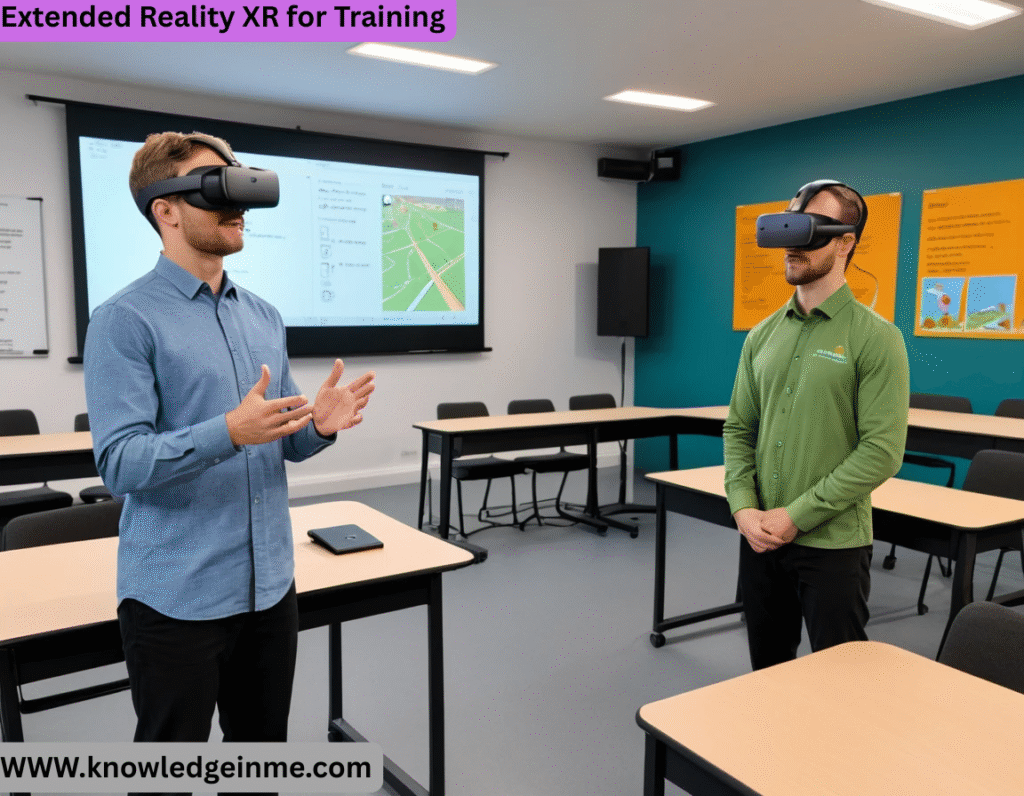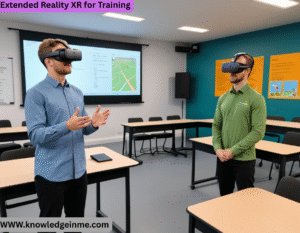Extended Reality XR for Training XR-based training enhances engagement, retention, and practical skills application, making it a powerful tool for workforce development.
Key Benefits of XR for Training
Immersive Learning Environments
- Trainees can practice in realistic, simulated scenarios (e.g., medical surgeries, hazardous industrial work, military operations).
Safe & Risk-Free Practice
- High-risk tasks (e.g., firefighting, electrical repairs, flight simulations) can be trained without real-world consequences.
- Reduces accidents and equipment damage.
Cost-Effective & Scalable
- Eliminates the need for physical setups (e.g., flight simulators, machinery).
- Digital modules can be updated and distributed globally.
Enhanced Knowledge Retention
- Hands-on, experiential learning improves memory retention compared to traditional methods.
- Interactive assessments provide real-time feedback.
Remote & Collaborative Training
- Useful for global enterprises and remote workforce upskilling.
Industries Leveraging XR Training
- Healthcare: Surgical simulations, patient diagnostics, and emergency response training.
- Manufacturing & Engineering: Equipment operation, safety protocols, and maintenance.
- Military & Defense: Combat simulations, tactical training, and PTSD therapy.
- Aviation & Automotive: Pilot/driver training, cockpit simulations, and assembly line processes.
- Corporate & Retail: Soft skills training, customer service simulations, and virtual onboarding.
Future Trends in XR Training
- AI Integration: Adaptive learning paths based on trainee performance.
- Haptic Feedback: Enhanced realism through touch sensations.
- 5G & Cloud XR: Faster, more accessible training with low-latency streaming.
- Metaverse Training Hubs: Persistent virtual campuses for continuous learning.
Advanced Applications of XR in Training
Medical & Healthcare Training
- Surgical Simulations: VR allows surgeons to practice complex procedures (e.g., laparoscopic surgery) in a risk-free environment.
- Example: OSSO VR provides orthopedic surgical training with haptic feedback.
- Patient Interaction Training: AR overlays virtual patients for diagnosis practice.
- Mental Health & Therapy: VR exposure therapy helps treat PTSD, phobias, and anxiety disorders.
Industrial & Manufacturing Training
- Equipment Maintenance: AR glasses (e.g., Microsoft HoloLens) guide technicians through repair steps with real-time instructions.
- Safety Drills: VR simulates hazardous scenarios (chemical spills, fires) for emergency response training.
- Assembly Line Training: Workers learn processes in a virtual factory before handling real machinery.
Military & Defense
- Combat Simulations: VR-based warzone training improves decision-making under pressure.
- Flight & Vehicle Simulations: Pilots and tank operators train in hyper-realistic environments.
- Cyber Warfare Training: XR helps simulate cyberattack scenarios for defense teams.
Corporate & Soft Skills Training
- Leadership & Communication: VR role-playing helps managers practice difficult conversations.
- Sales Training: AR simulates customer interactions with AI-driven responses.
- Diversity & Inclusion: VR places employees in scenarios to understand bias and cultural differences.
Education & Academia
- Virtual Labs: Students conduct chemistry or physics experiments without physical materials.
- Historical Reenactments: AR brings history lessons to life (e.g., walking through ancient Rome).
- Language Learning: VR immerses learners in foreign-language environments.
Case Studies: Successful XR Training Implementations
Company Institution XR Application Outcome
Walmart VR for employee training (Black Friday scenarios, customer service) Reduced training time by 50%, improved retention
Boeing AR-guided aircraft assembly Reduced errors by 30%, faster onboarding
Pfizer VR lab training for pharmaceutical processes Improved compliance & efficiency
U.S. Army VR combat simulation (Synthetic Training Environment) Enhanced soldier readiness
Stanford University VR surgical training for medical students Higher precision in real operations
How to Implement XR Training in Your Organization
Identify Training Needs
- What skills need improvement? (Technical, soft skills, safety)
- Is XR the best solution, or can traditional methods suffice?
Choose the Right XR Technology
- VR (Fully Immersive): Best for high-risk simulations (e.g., surgery, flight training).
- AR (Assisted Reality): Ideal for on-the-job guidance (e.g., machinery repair).
- MR (Mixed Reality): Combines real and virtual worlds (e.g., collaborative design reviews).
Develop or Source XR Content
- Off-the-shelf solutions (e.g., Strivr, Talespin, EngageXR).
- Custom development (if industry-specific needs exist).
Deploy & Integrate with LMS
- Ensure compatibility with Learning Management Systems (LMS) for tracking progress.
Step 5: Measure Effectiveness
- Compare pre– and post-training performance.
- Gather trainee feedback on engagement and usability.
Emerging Trends in XR Training
AI-Powered Adaptive Learning
- AI analyzes trainee performance and adjusts difficulty in real-time.
- Example: VR + AI chatbots for personalized coaching.
Haptic Feedback & Sensory Integration
- Critical for medical and mechanical training.
Digital Twins for Real-World Replication
- Virtual replicas of factories, cities, or equipment for predictive training.
Metaverse & Persistent Virtual Training Hubs
- Always-on virtual campuses where employees train and collaborate.
.
Challenges & Solutions in XR Training Adoption
Challenge Solution
High initial costs Start with pilot programs, use cloud-based XR
Motion sickness in VR Use high-refresh-rate headsets, gradual acclimatization
Lack of standardization Partner with established XR training providers
Trainee resistance to new tech Gamify training, demonstrate ROI
Future Outlook: Where XR Training is Headed
- Wider adoption in SMEs (Small & Medium Enterprises) as costs decrease.
- Neural XR (Brain-Computer Interfaces) for ultra-immersive training.
Introduction: The XR Training Revolution
- Extended Reality (XR)—encompassing Virtual Reality (VR), Augmented Reality (AR), and Mixed Reality (MR)—is disrupting corporate
- training, education, and workforce development. Unlike traditional methods, XR enables experiential, hands-on learning in simulated or
- augmented environments, leading to faster skill acquisition, better retention, and safer practice.
This guide explores
- Core XR training technologies (VR, AR, MR)
- Industry-specific applications (Healthcare, Military, Manufacturing, etc.)
- Implementation strategies (How to adopt XR training)
- Cutting-edge advancements (AI, haptics, metaverse)
- ROI & success metrics (Measuring training effectiveness)
XR Training Technologies Explained
Virtual Reality (VR) – Full Immersion
- What it is: Completely digital, 360° environments.
- Best for: High-risk simulations (surgery, flight training, hazardous industrial work).
- Example: STRIVR (Walmart uses VR for employee onboarding).
Augmented Reality (AR) – Digital Overlays on Real World
- What it is: Superimposes digital info (text, 3D models) onto physical surroundings.
- Best for: On-the-job guidance (equipment repair, assembly instructions).
- Example: Microsoft HoloLens (Boeing uses AR for aircraft assembly).
Mixed Reality MR Blending Real & Virtual Worlds
- What it is: Virtual objects interact with the real environment in real-time.
- Best for: Collaborative training (remote teams working on a virtual prototype).
- Example: Magic Leap (Medical students practice surgeries with MR).
Industry Specific XR Training Applications
Industry XR Training Use Case Real-World Example
Healthcare VR surgical simulations, AR-guided diagnostics OSSO VR (surgical training)
Manufacturing AR-assisted machinery repair, VR safety drills Siemens AR maintenance guides
Military & Defense VR combat training, drone pilot simulations U.S. Army’s Synthetic Training Environment
Aviation VR flight simulations, cockpit procedure training Lufthansa VR pilot training
Corporate Training VR leadership simulations, AR onboarding PwC’s VR soft skills training
Education Virtual labs, historical AR experiences Google Expeditions (AR field trips)
How to Implement XR Training: A Step-by-Step Guide
Step 1: Assess Training Needs
- Identify gaps: Is XR needed for safety, efficiency, or engagement?
- Compare costs: Will XR reduce long-term training expenses.





